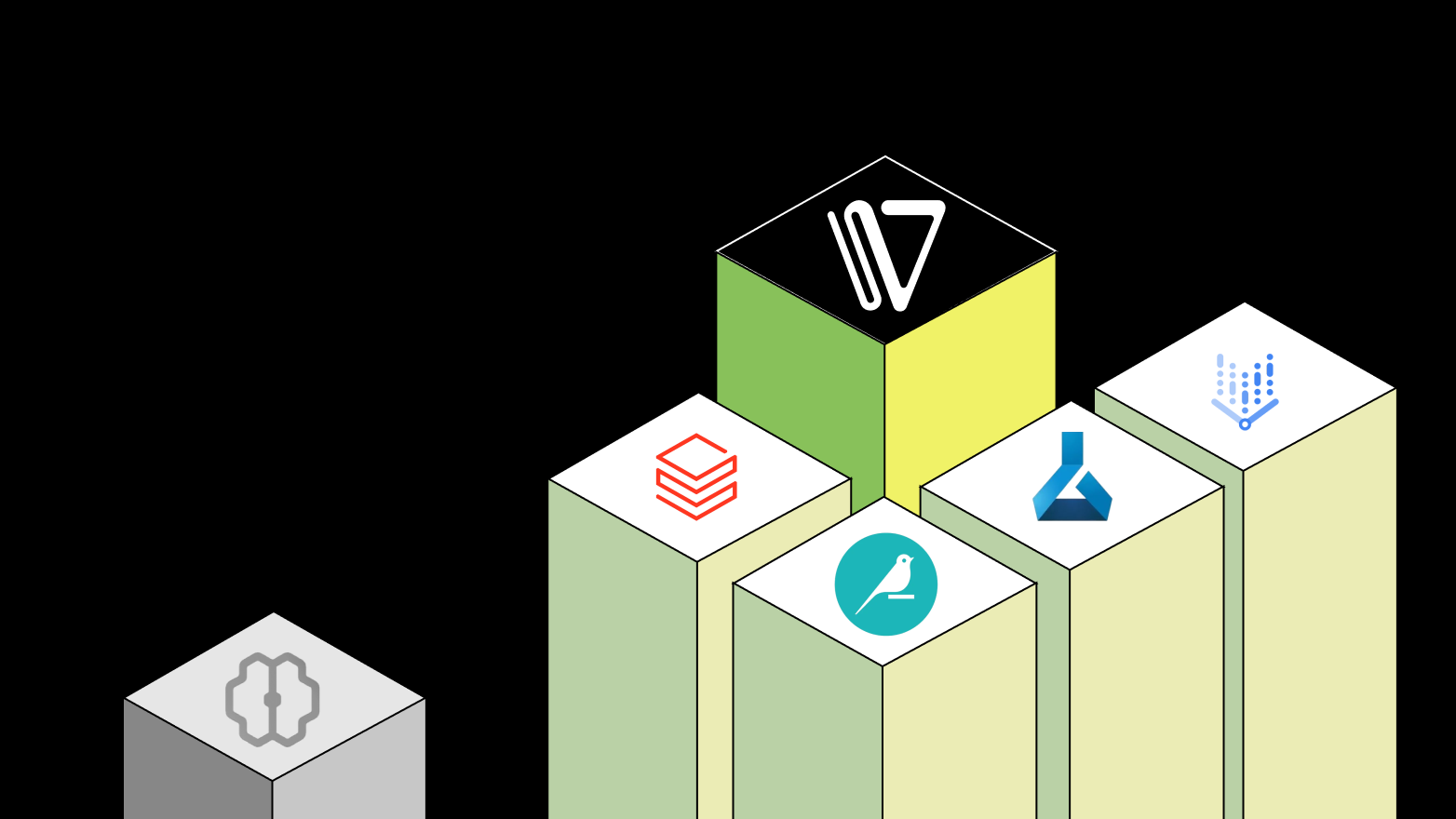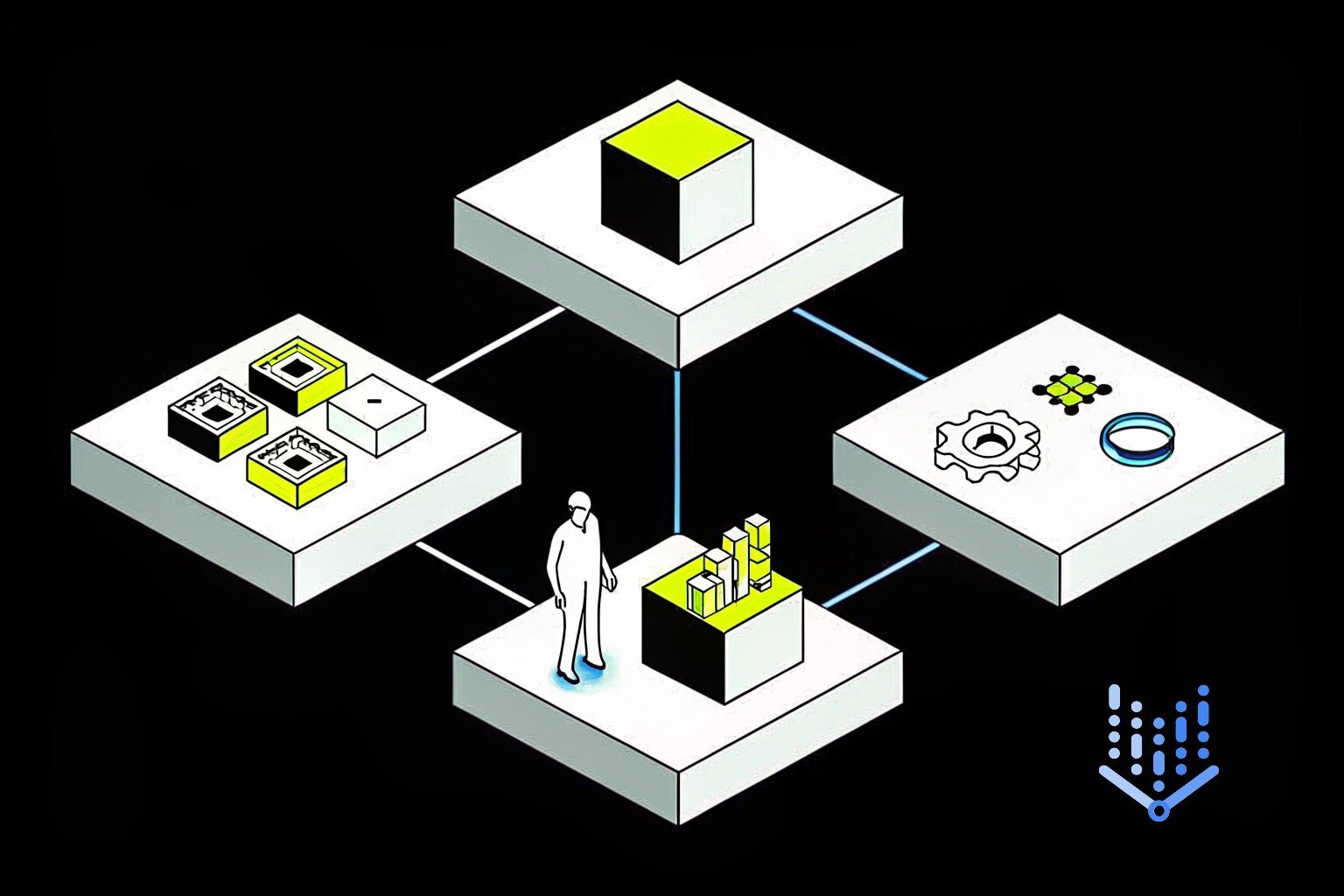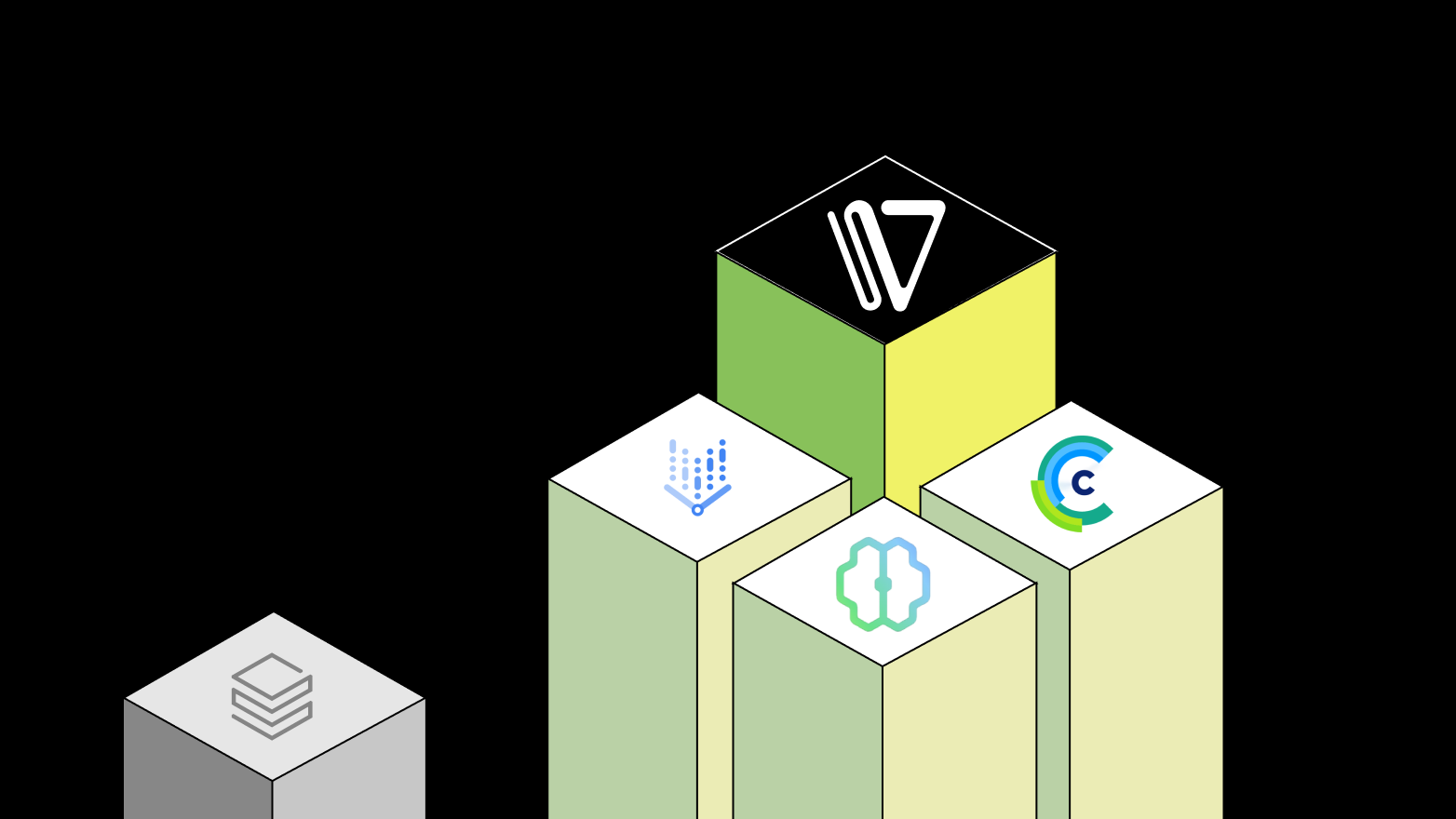Beyond SageMaker: AI Platforms Built for Speed, Data Control, and Security

As enterprise AI initiatives mature, the infrastructure powering them is under pressure to keep up. Amazon SageMaker, first released in 2017, has long been a go-to platform for building, training, and deploying AI at scale on AWS. It offers a managed environment for orchestrating the full AI/ML lifecycle—from data labeling and preprocessing to training, deployment, and monitoring—all tightly integrated within the AWS ecosystem.
Key takeaways:
- SageMaker is falling behind modern AI needs, especially for teams working with Generative AI / Agents.
- Security, data control, and modularity are now critical buying criteria—and platforms that embrace open source move faster and offer more flexibility.
- Cake delivers enterprise-grade AI infrastructure that’s open, cloud-agnostic, and cost-effective—saving teams $500K–$1M/year in engineering overhead and 6-12 months of time on their AI journeys.
In 2023, AWS introduced Amazon Bedrock, a platform focused specifically on GenAI workloads. Bedrock provides API-based access to proprietary foundation models like Anthropic’s Claude and Amazon’s Titan, making it easy to experiment without managing infrastructure. But while Bedrock is designed for convenience, it offers limited customization, no direct access to models, and remains deeply tied to the AWS stack. For teams building domain-specific, agentic, or fine-tuned GenAI systems, this creates real constraints.
But today’s AI landscape is evolving fast. Teams are now working with retrieval-augmented generation (RAG) pipelines, agent frameworks, and custom model fine-tuning workflows that require faster iteration cycles and access to the latest innovations—often driven by the open source community. What once made SageMaker and Bedrock appealing—deep AWS integration—is now often what holds teams back.
As a result, many organizations are reevaluating their stack. They’re looking for modular, open AI platforms that give them the freedom to assemble best-in-class tools, adopt new innovations as they emerge, and move fast without compromising on security or control. In this guide, we explore when it might be time to move beyond SageMaker and Bedrock—and what to look for in an AI development platform built for 2025 and beyond.
Why teams are looking beyond SageMaker
AWS SageMaker has been a staple for enterprise AI workflows, but for many teams, it’s starting to show its limits. As AI use cases shift to more complex real-time GenAI applications and agents, the cracks in SageMaker’s architecture become more visible.
You might be ready for a SageMaker alternative if:
Your team is drowning in AWS glue code instead of shipping features.
Your costs are ballooning with every new model or training run.
Security, auditability, or data residency requirements are forcing you to build workarounds.
Your GenAI stack (LLMs, vector DBs, RAG pipelines) doesn’t fit neatly into SageMaker’s tooling.
You’ve tried Bedrock but need deeper control over models, fine-tuning, or orchestration—beyond what a hosted API can provide.
You’re experimenting with agents—one of the most powerful GenAI patterns today—but SageMaker and Bedrock aren’t built for the orchestration, tool use, or modularity agents require.
You need the flexibility to work on-prem or hybrid, but SageMaker keeps you locked into AWS.
If any of these sound familiar, you’re not alone. Across industries, teams are shifting toward more open, flexible, and developer-friendly platforms that support modern AI workloads, without the friction or lock-in.
Meet the top SageMaker alternatives of 2025
If SageMaker is starting to feel like more of a constraint than a solution—whether due to cloud lock-in, slow innovation cycles, or the overhead of integrating legacy tooling—you’re not alone.
The good news? A new generation of AI platforms is stepping up—designed for teams that need security, control, and flexibility, without hiring a team of 50 engineers to build and maintain it all themselves.
But choosing the right platform means knowing what matters in 2025. Here are the key criteria shaping that decision:
- Modular architecture: Can you build the stack you actually want, using best-in-class tools instead of a fixed menu of features? Modularity lets you move fast, stay flexible, and adopt new innovations as they emerge.
- Security and data control: Are enterprise-grade security features (like fine-grained access controls, audit logging, and secrets management) baked into the core? Managing sensitive data requires more than checkbox compliance.
- Innovation speed: Does the platform keep pace with the latest open source breakthroughs? Falling behind in a field that changes weekly means missed opportunities and wasted time.
- Total cost of ownership: Are you saving time and resources, or spending months integrating and maintaining tools? The right platform should reduce complexity, not increase it.
The alternatives below take different approaches to solving these challenges. Whether you’re looking for total control, ease of deployment, or a future-proof foundation for AI, this guide will help you find the best fit.
Custom in-house AI builds
Best for: Organizations with deep infrastructure engineering teams and highly specialized needs.
A custom-built AI platform gives you complete control over every component of your stack—from model training pipelines to orchestration, observability, and deployment. Teams hand-pick open source tools, wire them together, and manage the infrastructure themselves. It’s the DIY approach to AI, often appealing to technically sophisticated teams looking to optimize for flexibility.
Pros:
- Maximum control over architecture and tooling
- Tailored exactly to your use case
- Can fully align with internal security, compliance, and performance requirements
Limitations:
- Requires significant engineering investment to build and maintain
- Long ramp-up time (often 6–12 months, if not more)
- Risk of tool fragmentation and integration drift
- Cost of ongoing maintenance and upgrades often underestimated
Stock managed cloud service AI platforms
Best for: Organizations already deeply committed to a single cloud provider and running relatively straightforward AI workloads.
Like AWS, the other major cloud providers offer their own end-to-end machine learning platforms (e.g., Google Vertex AI and Azure Machine Learning) designed to simplify the AI lifecycle within their ecosystems. These platforms bundle everything from training and tuning to deployment and monitoring, with the promise of scalability and integration with cloud-native services.
Google’s Vertex AI includes tight integrations with Gemini, their flagship LLM family, and offers pre-trained models along with AutoML tooling. Azure Machine Learning emphasizes enterprise-grade compliance, role-based access, and integrations with Microsoft tools like Power BI and Azure DevOps. But they have many of the same setbacks that SageMaker does, e.g., cost and incapability with the latest and greatest open source technologies.
Note: Precious few orgs will switch cloud services based on their stock AI development platforms (we certainly don’t endorse that), but we included these options as they are part of the landscape.
Pros:
- Easy to integrate if your infrastructure is already 100% on that cloud
- Enterprise-ready security and compliance features
- Managed services reduce infrastructure overhead
- Access to proprietary foundation models (e.g., Gemini)
Limitations:
- Vendor lock-in is significant—you’re tied to that cloud’s pricing, ecosystem, and roadmap
- Switching cloud providers just to use a different AI platform is unrealistic for most teams
- Tooling can lag behind the open source ecosystem
- Limited flexibility for hybrid or on-prem deployments
- Higher long-term costs due to premium pricing on managed services
AI development platforms
Databricks
Best for: Organizations already invested in a lakehouse architecture or collaborative data science workflows.
Databricks is a unified analytics and ML platform built on top of Apache Spark. It popularized the “lakehouse” paradigm, which blends the data governance and performance benefits of data warehouses with the flexibility of data lakes. Databricks provides tools for data engineering, collaborative notebooks, model training, and deployment within a single interface.
Founded in 2013 by the original creators of Apache Spark, Databricks has grown into one of the most well-funded data infrastructure companies. It’s widely adopted in enterprises that want to consolidate data science and data engineering workflows on the same platform.
Pros:
- Strong integration with Delta Lake and MLflow
- Support for both traditional ML and GenAI workloads
- Ideal for AI teams that need direct access to massive datasets without complex ETL, as it combines data engineering, data science, and machine learning in one ecosystem
- Compatible with major OSS frameworks including PyTorch, TensorFlow, Hugging Face, and LangChain
Limitations:
- Heavy reliance on Spark can introduce unnecessary complexity for teams not already using it, making it less tailored for GenAI-specific use cases
- Introduces overhead for smaller teams or GenAI-only workloads that don't require a dedicated warehouse
- Offers less “plug-and-play” usability than lighter GenAI platforms like Replicate or Hugging Face Hub
Dataiku
Best for: Organizations focused on operationalizing basic AI models across business teams rather than pushing the boundaries of what AI can do.
Dataiku positions itself as a collaborative AI platform for both technical and non-technical users, emphasizing visual workflows, low-code interfaces, and built-in governance. It’s often adopted by large enterprises looking to democratize AI across business units.
Its strength lies in helping analysts and domain experts build simple models without writing code. For AI teams building more advanced systems—like agentic architectures, fine-tuned LLMs, or RAG pipelines—Dataiku can become a limiting environment. Its visual-first design and abstraction layers create friction for engineers who want hands-on control and flexibility.
Pros:
- Visual interface appeals to analysts and business users
- Built-in data prep, AutoML, and reporting features
- Strong enterprise features like access controls and project governance
- Good for standardized workflows across distributed teams
Limitations:
- Limited flexibility for advanced AI use cases or custom architectures
- Not designed for cutting-edge open source tooling
- Abstraction layers can be frustrating for engineering teams
- Cost can scale quickly as usage and user seats expand
Cake
Best for: Best for: Teams that want the control of “build,” with the speed of a “buy.”
Cake is a modern, cloud-agnostic AI development platform designed to help teams deploy production-grade ML, GenAI, and agents faster, without vendor lock-in, compliance gaps, or complex DIY infrastructure.
Unlike SageMaker, which requires stitching together AWS-native services, Cake ships as a modular, open-source-first platform that runs entirely in your infrastructure, across any cloud, on-prem, or hybrid environment. Its plug-and-play architecture lets teams assemble a best-in-class AI stack using pre-integrated components like Ray, MLflow, LangChain, and more.
Whether you’re deploying fine-tuned foundation models, scaling RAG pipelines, or orchestrating multi-model systems, Cake abstracts away operational complexity while maintaining full visibility and control.
Founded by engineers from Stripe, OpenAI, and other cloud-native leaders, Cake was built to solve the pain points they encountered firsthand: vendor lock-in, fragmented MLOps workflows, and compliance blind spots. Today, Cake powers AI workloads for teams building everything from RAG-based copilots to enterprise-grade LLM systems.
Key advantages over SageMaker:
- Cloud agnostic: Run GenAI workloads anywhere—AWS, Azure, GCP, or on-prem
- No vendor lock-in: Bring your own models, data, and runtime environments. Every component in Cake is open-source, which eliminates any vendor lock-in
- Security and compliance built-in: Enterprise-grade controls, auditability, and policy enforcement baked in
- Optimized for GenAI: Fine-tuned for deploying, scaling, and iterating on foundation models like Llama, Mistral, Claude, and others
- Faster time to value: Teams typically save 6–12 months of engineering effort and 30–50% on infrastructure costs
If you're building production-grade AI and want to move quickly without compromising flexibility, Cake is a powerful alternative to consider.
Finding AI success with Cake
After running into cost and privacy issues with external LLM APIs, Glean.ai switched to Cake to fine-tune and deploy its own foundation model.
✅ Model accuracy improved from 70% to 90%
✅ Operating costs dropped by 30%
✅ Saved 2.5 FTEs without growing the team
Cake co-founder & CTO Skyler Thomas at the 2025 Data Council 2025 in Oakland, CA, on scaling real-world RAG and GraphRAB systems with open-source technologies.
Compare: SageMaker vs. Top Alternatives
Choosing the right platform depends on your goals—whether it’s speeding up GenAI deployment, improving portability, or gaining more control over compliance and infrastructure. Here’s a side-by-side comparison to help you evaluate:
|
Modular architecture |
Security & data control |
Cutting-edge open source |
Cost efficiency (TCO) |
|
|
Custom build |
✅ Full control over components |
✅ Can be tightly secured if built correctly |
✅ Direct access to latest OSS (if maintained) |
❌ High cost in engineering time and maintenance |
|
Cloud platforms |
❌ Limited—vendor-defined stack |
✅ Enterprise features, but locked into cloud |
❌ Often 1–2 years behind open source |
❌ Expensive managed services + egress fees |
|
Databricks |
⚠️ Moderate—some integration flexibility, but tightly coupled |
⚠️ Some enterprise controls, but limited visibility |
❌ Slower to adopt GenAI and OSS trends |
⚠️ Costly at scale, especially for full-stack workloads |
|
Dataiku |
❌ Closed platform, low extensibility |
✅ Strong governance tools |
❌ Not designed for OSS ecosystem |
❌ License + seat-based costs scale quickly |
|
Cake |
✅ Fully modular, curated open source stack |
✅ Enterprise-grade security + full control over data |
✅ Tracks latest OSS within weeks of release |
✅ Saves $500K–$1M+ annually by managing infra for you |
Choosing AI development that keeps you ahead
SageMaker still works for organizations with relatively simple AI needs and deep investment in the AWS ecosystem. But as the AI landscape evolves—especially with the rise of GenAI and custom architectures—teams are increasingly running into limits around cost, agility, and control.
Modern platforms like Cake are redefining what enterprise AI infrastructure looks like. With modular design, enterprise-grade security, and a fast path to open source innovation, Cake gives teams full control over how they build and scale AI—without the integration burden or vendor lock-in of legacy solutions.
If your AI strategy depends on staying ahead, not just keeping up, the platform you choose matters. Look for one that keeps you agile, secure, and future-ready. With Cake, you’re not just getting a platform—you’re getting a modular, always-up-to-date foundation that evolves alongside the AI ecosystem. From RAG to fine-tuning to next-gen agents, Cake keeps you on the frontier without the complexity of stitching it together yourself.
Related articles
- The Future of AI Ops: Exploring the Cake Platform Architecture
- "DevOps on Steroids" for Insurtech AI
- Cake’s Platform Overview
- How Glean Cut Costs and Boosted Accuracy with In-House LLMs
Frequently asked questions
What is AWS SageMaker, and how is it used in enterprise AI?
AWS SageMaker is a managed platform that helps teams build, train, and deploy AI models at scale. It supports end-to-end development workflows, but is tightly integrated with the AWS ecosystem and best suited for teams fully invested in that environment.
Why are teams looking for SageMaker alternatives?
As enterprise AI becomes more modular, fast-moving, and cloud-agnostic, many teams are outgrowing SageMaker. Key reasons include high operational costs, limited support for modern GenAI workloads, slow adoption of new open source tools, and the risk of vendor lock-in.
What should I look for in a SageMaker alternative?
Today’s leading AI platforms should offer:
- Modular architecture to support custom workflows
- Hybrid deployment options
- Built-in security, compliance, and governance features
- Native support for GenAI workloads (e.g., LLMs, RAG, fine-tuning)
- Cost savings through efficient infrastructure and reduced engineering burden
Is SageMaker good for GenAI workloads?
SageMaker offers some support for GenAI through model integrations and managed compute, but it lacks the flexibility needed for teams working on custom fine-tuning, RAG pipelines, or agentic systems. Its pace of innovation also lags behind the open source ecosystem.
What is the best SageMaker alternative for enterprises?
If you’re building GenAI applications at scale and care about security, flexibility, and innovation speed, Cake is a strong alternative. It brings together the latest open source components in a modular, cloud-agnostic architecture—cutting infrastructure complexity and saving most teams $500K–$1M annually in engineering cost.
Does switching from SageMaker require migrating all my AI assets?
No. Some platforms—including Cake—allow for gradual, component-level migration. With Cake, you can integrate into your existing stack, replace one component at a time, or run parallel workloads—without needing to rewrite everything or rip out your AWS investment. Every component in Cake is modular and interoperable, giving you full control over how and when you migrate.
How does Amazon Bedrock compare to SageMaker or Cake?
Amazon Bedrock is AWS’s managed service for GenAI that offers API access to foundation models like Claude, Titan, and others. It’s designed for ease of use, not deep customization. While it’s a fast way to experiment with hosted models, Bedrock doesn’t offer the infrastructure flexibility, modularity, or control needed for most production-grade AI systems. Platforms like Cake provide a more open, customizable foundation for teams building with open source, deploying across clouds, or fine-tuning models in-house.
About Author

Cake Team
More articles from Cake Team
Related Post

Google Vertex Alternatives: Portability, Compliance, and Control

Cake Team

Top Databricks Alternatives for Modern AI Development in 2025

Cake Team

Save $500K–$1M Annually on Each LLM Project with Cake

Cake Team

Real-World AI Applications: Transforming Industries

Cake Team